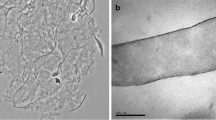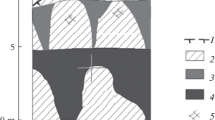Abstract
Thermophilic obligately autotrophic hydrogen-oxidizing bacteria were isolated from several alkaline hot springs in Iceland. The bacteria were Gram negative rods, 0.4–0.5 μm in diameter and 3–4 μm long but 6–7 μm long cells without septa were often seen. Long and short laments are formed. Spores, flagella or lipid granules were not observed. Strains H1 and H12 grew optimally at 70° C and pH 6.5 under mixture of air plus 0.6 atm H2 and 0.1 atm CO2. The cells contained cytochromes and carotenoid-like pigments. They would not grow on agar or silicia gel plates. The cells would not grow heterotrophically on organic substrates and were inhibited by most of these same organic compounds and agar in low concentrations. They were very sensitive to common antibiotics. The role of these bacteria in the hot spring ecosystem is discussed.
Similar content being viewed by others
References
Aragno M (1978) Enrichment, isolation and preliminary caracterization of a thermophilic, endospore-forming hydrogen bacterium. FEMS Microbiol Lett 3:13–15
Aragno M, Schlegel HG (1981) The hydrogen-oxidizing bacteria. In: Starr MP, Stolp H, Trüper HG, Balows A, Schlegel HG (eds). The prokaryotes. Springer, Berlin Heidelberg New York, pp 865–893
Badziong W, Thauer RK, Zeikus JG (1978) Isolation and characterization of Desulfovibrio growing on hydrogen plus sulfate as the sole energy source. Arch Microbiol 116:41–48
Bowien B, Schlegel HG (1981) Physiology and biochemistry of aerobic hydrogen-oxidizing bacteria. Ann Rev Microbiol 35:405–452
Brock TD (1978) Thermophilic microorganisms and life at high temperatures. Springer, New York
Brock TD, Brock ML (1967) The measurement of chlorophyll, primary productivity, photophosphorylation, and macromolecules in benthic algal mats. Limnol Oceanogr 12:600–605
Castenholz RW (1969) The thermophilic cyanophytes of Iceland and the upper temperature limit. J Phycol 5:360–368
Castenholz RW (1976) The effect of sulfide on the bluegreen algae of hot springs. I. New Zealand and Iceland. J Phycol 12: 54–68
Degryse E, Glansdorff N, Piérard (1978) A comparative analysis of extreme thermophilic bacteria belonging to the genus Thermus. Arch Microbiol 117:189–196
De Ley J (1970) Reexamination of the association between melting point buoyant density, and chemical base composition of deoxyribonucleic acid. J Bacteriol 101:133–142
Ericsson JLE, Brunk UT, Arborgh B (1978) Fixation. In: Johannessen JV (ed) Electron microscopy in human medicine, Instrumentation and techniques. McGraw-Hill, New York vol. 1 pp 99–184
Gillis M, De Ley J, De Cleene M (1970) The determination of molecular weight of bacterial genome DNA from renaturation rates. Eur J Biochem 12:143–153
Haschemeyer RH, Myers RJ (1972) Negative staining. In: Hayat MA (ed) Principles and techniques of electron microscopy. vol 2, Biological applications. Van Nostrand Reinhold Co, New York, pp 99–147
Hayat MA (1970) Principles and technique of electron microscopy, vol 1, Biological applications. Van Nostrand Reinhold Co, New York
Hilpert R, Winter J, Hanmes W, Kandler O (1981) The sensitivity of archaebacteria to antibiotics. Zbl Bakt Hyg I. Abt Orig C 2:11–20
Kawasumi T, Igarashi Y, Kodama T, Minoda Y (1980) Isolation of strictly thermophilic and obligately autotrophic hydrogen bacteria. Agric Biol Chem 44:1985–1986
Kawasumi T, Igarashi Y, Kodama T, Minoda Y (1984) Hydrogenobacter thermophilus gen. nov., sp. nov., an extremely thermophilic, aerobic, hydrogen-oxidizing bacterium. Int J Syst Bacteriol 34:5–10
Kristjansson JK, Alfredsson GA (1983) Distribution of Thermus spp. in Icelandic hot springs and a thermal gradient. Appl Environ Microbiol 45:1785–1789
Marmur J (1963) A method for the isolation of deoxyribonucleic acid from microorganisms. In: Colowick SP, Kaplan NO (eds) Methods in enzymology, vol VI. Academic Press, New York, pp 726–738
Schenk A, Arango M (1979) Bacillus schlegelii, a new species of thermophilic, facultatively chemolithotrophic bacterium oxidizing molecular hydrogen. J Gen Microbiol 115:333–341
Sigvaldason GE, Eliasson G (1968) Collection and analysis of volcanic gases at Surtsey, Iceland. Geochim Cosmochim Acta 32:797–805
Stainer RY, Adelberg EA, Ingraham JL (1977) General microbiology, fourth edition. The Macmillan Press Ltd, London
Wiegel J, Ljungdahl, LG (1981) Thermoanaerobacter ethanolicus gen. nov., spec. nov., a new extreme thermophilic, anaerobic bacterium. Arch Microbiol 128:343–348
Woese CR, Magrum LJ, Fox GE (1978) Archaebacteria. J Molec Evol 11:245–252
Zillig W, Stetter KO, Schäfer W, Janekovic D, Wunderl S, Holz I, Palm P (1981) Thermoproteales: A novel type of extremely thermoacidophilic anaerobic archaebacteria isolated from Icelandic solfataras. Zbl Bakt Hyg I. Abt Orig C 2:205–227
Author information
Authors and Affiliations
Rights and permissions
About this article
Cite this article
Kristjansson, J.K., Ingason, A. & Alfredsson, G.A. Isolation of thermophilic obligately autotrophic hydrogen-oxidizing bacteria, similar to Hydrogenobacter thermophilus, from Icelandic hot springs. Arch. Microbiol. 140, 321–325 (1985). https://doi.org/10.1007/BF00446971
Received:
Accepted:
Issue Date:
DOI: https://doi.org/10.1007/BF00446971




